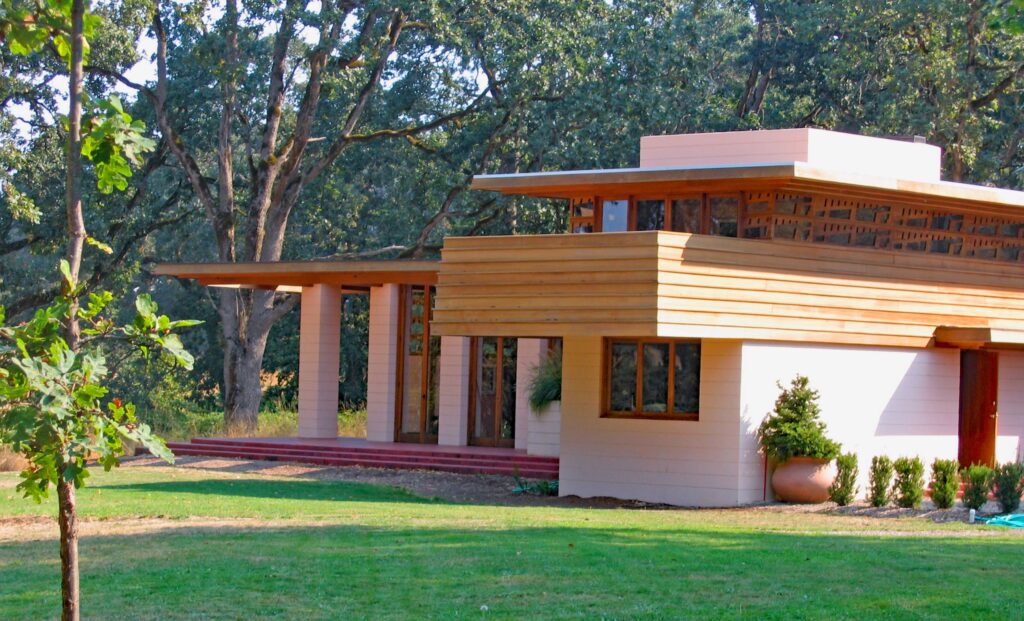Frank Lloyd Wright, the architect who popularized indoor-outdoor living, will be celebrated Saturday, a day before the 158th anniversary of his birth, at
the Gordon House
in Silverton, Wright’s only design built in Oregon.
From 11 a.m. to 4 p.m., visitors to the Gordon House at
869 W. Main St.
can see the interior of the two-story dwelling with decorative geometric fretwork and walls of glass rising 12 feet to the ceiling ($5 for adults, under 18 are free).
They will also hear the fascinating story of the significant structure that was saved from demolition and moved near
the Oregon Garden
where it was
reconstructed
and opened to the public in March 2002. Since then, more than 100,000 people have explored Wright’s handsome approach to indoor-outdoor living.
Donations
, admission and merchandise sales support the
nonprofit Gordon House Conservancy’s
educational and preservation mission.
Conservancy members
and
volunteers
care for the house and grounds.
The latest improvement projects include restoring and preserving the cedar siding thanks to a grant from the
Oregon State Historic Preservation Office
and a donation by Brendan Rhoney, owner of
Western Accents
, a fine painting and wood finishing company in Hillsboro.
Visitors will also notice a new coat of paint on the interior and exterior block work.
Guided, 45-minute tours
of the only Wright residence open to the public in the Pacific Northwest are offered throughout the year ($20, 503-874-6006;
thegordonhouse.org
). Private tours and use of the grounds for events are also available.
Wright, who lived from
June 8, 1867, to April 9, 1959
, famously said: “We have no longer an outside and an inside as two separate things. Now the outside may come inside, and the inside may and does go outside. They are of each other. Form and function thus become one in design and execution if the nature of materials and method and purpose are all in unison.”
Also on view: Last year’s landscaping improvements. Wright believed his “organic architecture” could enhance natural features. “Landscape seen through the openings of the building thus placed and proportioned has greater charm than when seen independent of the architecture,” he said.
A walkway connects to the
1.3-mile Oregon Garden Loop
and a pathway on the west side of the home was installed to complete an “outdoor room” as Wright envisioned.
Relocating the historic landmark 23 years ago to an oak grove was a struggle, physically and financially, but careful positioning of the house preserved the exact solar orientation as the original location, according to Dave Pierce, board chairman of the Gordon House Conservancy.
The move and ongoing upgrades also achieve Wright’s preference for expansive windows framing native plants and interior floors extending to terraces, “making the inhabitants feel they are living as part of the environment of the home,” Pierce told The Oregonian/OregonLive.
Moving a masterwork
In 1957, while Wright was still creating the exalted
Guggenheim
art museum
in New York City, he accepted a $25,000 commission to design a modern house for Evelyn and Conrad Gordon on their farmland near Wilsonville.
Wright was almost 90 years old at the time and had spent more than two decades developing suburban housing with high architectural quality at a moderate price.
He called his innovative style “Usonian,” which he defined as living in harmony with the land in the United States of North America (USONA), and he said the houses had an organic appearance as if rising “out of the ground and into the light.”
His Usonian plans, as seen at the Gordon House, typically had a flat roof with generous, shade-making overhangs.
The cedar-and-concrete-block Gordon House, completed in 1964, five years after Wright died, was positioned on the farm to capture views of the adjacent Willamette River on the northwest side and Mount Hood to the east.
Perforated boards, or fretwork, screens were made to draw in light, ensure privacy and serve as an economical alternative to draperies or stained art glass, according to historians who successfully nominated the Gordon House to be listed in the
National Register of Historic Places
.
The open floor plan concept developed by Wright is evident in the great room, which has dining and living areas as well as a concrete-block fireplace and a library with built-in seating.
Original owner
Evelyn Gordon was a weaver and artist
who saw her home as an accommodating sequence of galleries to display her paintings, prints and sculptures.
Original paintings, many by Northwest artists, hung on every wall, including in the kitchen where cinder blocks rise 15 feet to meet a skylight. She displayed Native American weavings, a metal sculpture by James Shull and — sharing Wright’s passion for Japanese art — a Haku Maki woodblock print.
Evelyn Gordon was a widow when she died in 1997 and the property, which had years of deferred maintenance, was sold to new owners who tried to get the Gordon House removed from the
Clackamas County List of Historic Structures
and then demolished.
Instead, in 2001, the
Frank Lloyd Wright Building Conservancy
, a Chicago-based organization devoted to preserving Wright’s built legacy, negotiated an agreement with the owners to donate the architecturally significant dwelling.
A stipulation of the agreement required the 2,133-square-foot house be relocated within 105 days. The conservancy accepted a proposal from the
Oregon Garden Society
, assisted by the City of Silverton, to take charge of moving and reinstalling the house.
The structure was carefully dismantled by preservationists and volunteers, and the four sections were moved 21 miles southeast to the Oregon Garden site over three days, arriving March 11, 2001, four days ahead of the deadline, say historians.
The structure’s siding and roofing were refurbished with grants from the
Architectural Foundation of Oregon
and the Oregon Cultural Trust, according to the Gordon House Conservancy.
A new foundation replicated the original north-south orientation, and since interior walls, doors, cabinets, wood trim, furniture and shelving are intact, the Gordon House “continues to present an accurate representation of Frank Lloyd Wright’s Usonian house design and subsequent construction for Conrad and Evelyn Gordon,” say historians.
Visitors can see every room, including the kitchen — what Wright called the “workspace” — and his ideas of paneled refrigerator doors, under-cabinet lighting and other features for cooking efficiency, comfort and speed that continue to
influence kitchen design today
.
Owning a Wright
The
Frank Lloyd Wright Building Conservancy
maintains a list at
savewright.org
of Wright-designed
homes on the market
across the country.
There has been a series of recent sales:
The horseshoe-shaped,
1955 Tirranna (“running water”) mansion
in New Canaan, Connecticut, with 7,000 square feet of living space sold in January 2024 for
$6 million
.
The
1949 Ward and Helen McCartney House
, a dramatic Usonian design formed by two triangles on a 1.12 acre property at
2662 Taliesin Drive
in Kalamazoo, Michigan’s Parkwyn Village, sold for
$670,000
June 2024. The sale included some original furniture and blueprints.
The
Fawcett House
, designed by Wright in 1955 to showcase seamless living indoors and out, sits on 76 acres in California’s Central Valley city of Los Banos, and sold for
$3,090,000
on Nov. 24, 2024.
The
1900 Warren Hickox House
in Kankakee, Illinois, is one of Wright’s first Prairie-style designs with flared roof ridges evocative of Japanese architecture. The 0.6-acre property, sold for
$449,000
on March 12, 2025.
Asking prices reflect the escalated value of his work:
-
The last house the architect designed before he died in 1959, the circularNorman Lykes House
, constructed of colored concrete block to blend with the
Phoenix Mountains Preserve
, is for sale at $8,950,000.
-
TheRichard Lloyd Jones House
in Tulsa, Oklahoma, built in 1929 of alternating piers of square glass windows and concrete “textile” blocks, is for sale at $3.5 million.
-
TheEppstein House
, designed by Wright in 1948 in Galesburg, Michigan’s The Acres, is for sale by owner at $2.1 million and is also
available for overnight stays.
Here is Oregon: Willamette Valley
-
Barn owl snagged by barbed wire saved by Oregon passersby, wildlife rescue team
-
Oregon Pride 2025: Parades, festivals and events planned statewide
-
Where to eat breakfast, lunch and dinner in Salem? Try these local favorites
-
Sacred Shore Wines conjures Galician magic in Oregon wine country: Winery spotlight
-
Querida hamburguesería del PNW ofrece una hamburguesa especial con queso galardonado de Oregón
— Janet Eastman covers design and trends. Reach her at 503-294-4072,
jeastman@oregonian.com
and follow her on X
@janeteastman
.




More Stories
Celebrate architect Frank Lloyd Wright’s birthday inside the only house he designed in Oregon
Celebrate architect Frank Lloyd Wright’s birthday inside the only house he designed in Oregon
Celebrate architect Frank Lloyd Wright’s birthday inside the only house he designed in Oregon